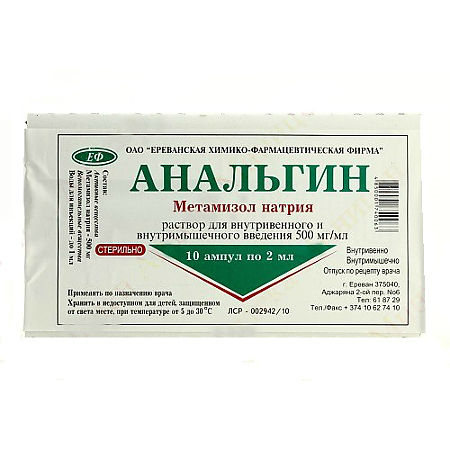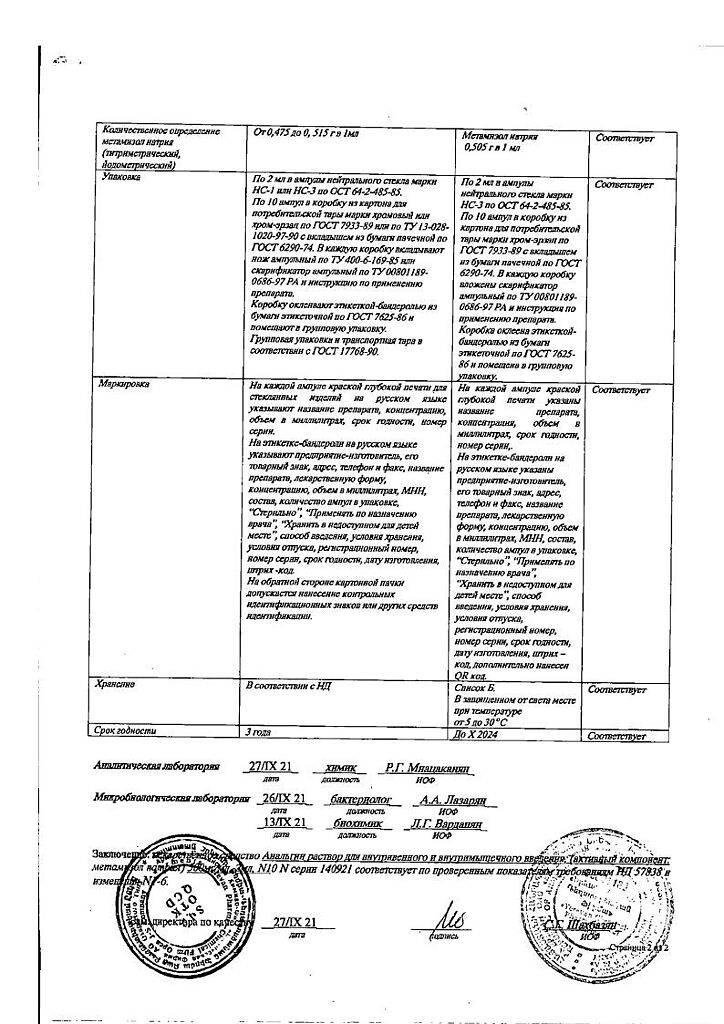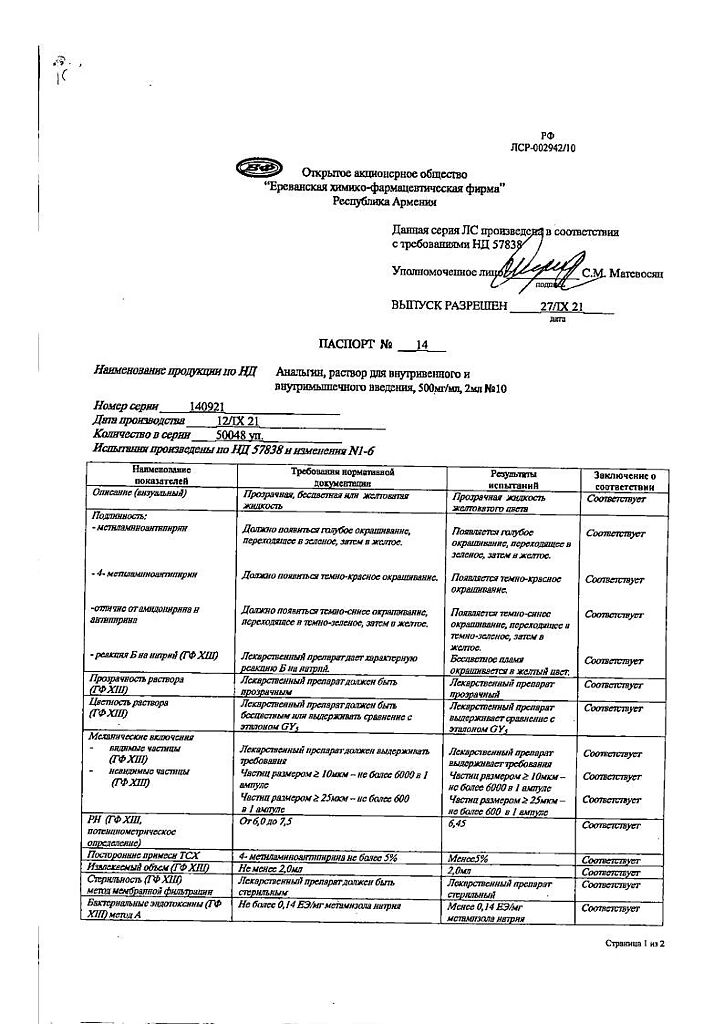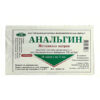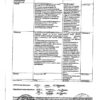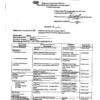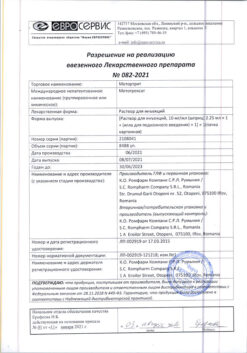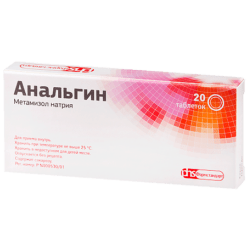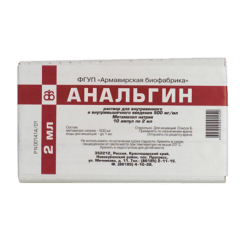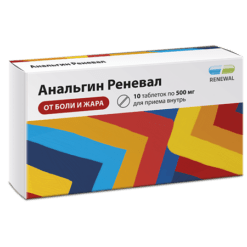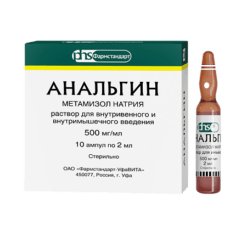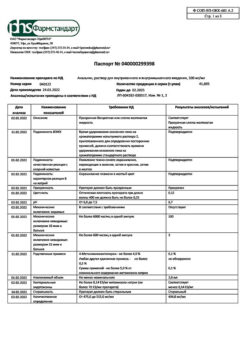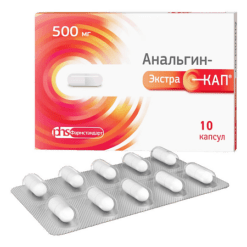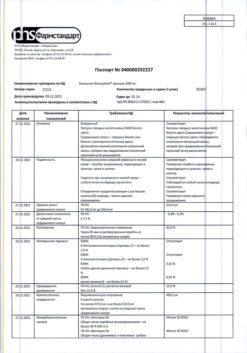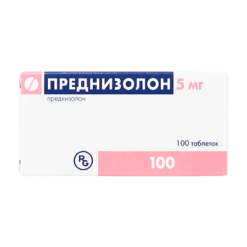No products in the cart.
Analgin 500 mg/ml 2 ml 10 pcs
€4.54 €3.78
Out of stock
(E-mail when Stock is available)
Description
Analgesic non-narcotic agent, pyrazolone derivative, non-selectively blocks COX and decreases formation of Pg from arachidonic acid. It prevents conduction of pain extra- and proprioceptive impulses along the Goll and Bourdach bundles, increases threshold of excitability of thalamic centers of pain sensitivity, increases heat release. A distinctive feature is a slightly pronounced anti-inflammatory effect, resulting in a weak effect on water-salt metabolism (Na+ and water retention) and the gastrointestinal mucosa. It has analgesic, antipyretic and some antispasmodic effect (on smooth muscles of urinary and biliary tracts). The action develops within 20-40 minutes after oral administration and reaches the maximum in 2 hours.
Indications
Indications
Fever syndrome (infectious and inflammatory diseases, insect bites – mosquitoes, bees, gadflies, etc., Post-transfusion complications); pain syndrome (mild to moderate): including neuralgia, myalgia, arthralgia, biliary colic, intestinal colic, renal colic, injuries, burns, decompression disease, shingles, orchitis, radiculitis, myositis, postoperative pain syndrome, headache, toothache, algodysmenorrhea.
The fever syndrome is a symptom of the disease.
Active ingredient
Active ingredient
Composition
Composition
1 ml of solution for injection contains:
active ingredient: sodium metamizole (analgin) 500 mg
How to take, the dosage
How to take, the dosage
Adults and adolescents 15 years and older: as a single dose, 1-2 ml of Analgin 500 mg/mL solution or 2-4 ml of Analgin 250 mg/mL solution (intramuscular or intravenous), the daily dose can be up to 4-8 ml of 500 mg/mL injection solution or 250 mg/mL injection solution (no more than 2 g), divided into 2-3 doses. The maximum single dose may be 1 g (2 ml of 500 mg/ml solution or 4 ml of 250 mg/ml solution).
Children and newborns: Analgin should not be administered to newborns under 3 months of age or with a body weight less than 5 kg.
In children, Analgin is prescribed in a dose of 5-10 mg per 1 kg of body weight (0.1-0.2 ml of 500 mg/ml solution or 0.2-0.4 ml of 250 mg/ml solution).
The dose can be administered up to 2-3 times a day.
We recommend warming the solution to body temperature before administration.
In children aged 3-12 months, the administration is only done intramuscularly! (the child’s body weight is 5 to 9 kg).
If the drug is given too quickly, a critical drop in blood pressure and shock may occur. Intravenous infusion should be carried out slowly (infusion rate of no more than 1 ml (500 mg of sodium methamisole per minute)) in the supine position, while monitoring blood pressure, pulse and respiratory rate.
Since there is concern that the drop in blood pressure of non-allergic origin is dose-dependent, amounts of Analgin solution greater than 2 ml (1 g) should be administered with extreme caution.
Interaction
Interaction
Because of the high likelihood of pharmaceutical incompatibility, do not mix with other drugs in the same syringe. Increases the effects of ethanol. X-ray contrast agents, colloidal blood substitutes and penicillin should not be used during treatment with sodium metamizole. Concomitant use of cyclosporine decreases the concentration of the latter in blood. Sodium metamizole displaces oral hypoglycemic drugs, indirect anticoagulants, GCS and indomethacin from binding to plasma proteins and increases their activity. Phenylbutazone, barbiturates and other inducers of microsomal liver enzymes reduce the effectiveness of sodium metamizole when administered simultaneously. Concomitant use with other non-narcotic analgesics, tricyclic antidepressants, contraceptive hormonal drugs and allopurinol can lead to increased toxicity. Sedatives and anxiolytic drugs (tranquilizers) increase the analgesic effect of sodium metamizole. Thiamazole and cytostatics increase the risk of leukopenia. The effect is enhanced by codeine, H2-histamine receptor blockers and propranololol (slows inactivation). Myelotoxic drugs increase manifestations of hematotoxicity of the drug.
Special Instructions
Special Instructions
In patients suffering from bronchial asthma and pollinosis it is possible to develop hypersensitivity reactions.
In long-term use (more than 7 days) the peripheral blood picture should be monitored. Agranulocytosis may develop during sodium metamizole administration; therefore, in case of unexplained fever, chills, sore throat, difficulty in swallowing, stomatitis, oral erosive ulcers, vaginitis or proctitis, the drug should be immediately stopped.
Do not use for treating acute abdominal pain (until the causes are determined).
To reduce the risk of gastrointestinal adverse events, use the lowest effective dose for the shortest possible course.
When treating patients receiving cytostatic drugs, sodium metamizole should only be taken under medical supervision.
A long needle should be used when administering intramuscularly.
Contraindications
Contraindications
Hypersensitivity, suppression of hematopoiesis (agranulocytosis, cytostatic or infectious neutropenia), hepatic and/or renal failure, hereditary hemolytic anemia associated with glucose-6-phosphate dehydrogenase deficiency, bronchial asthma induced by taking ASA, salicylates or others. NSAIDs, anemia, leukopenia, pregnancy (especially in I trimester and last 6 weeks), lactation.
Side effects
Side effects
Urinary system disorders: impaired renal function, oliguria, anuria, proteinuria, very rare development of acute interstitial nephritis, staining of urine red (due to excretion of the metabolite – rubazonic acid).
Allergic reactions: urticaria, including conjunctivitis and mucous membranes of the nasopharynx, Quincke’s edema; in rare cases – erythema malignant exudative (Stevens-Johnson syndrome), anaphylactic shock, toxic epidermal necrolysis (Lyell syndrome), bronchospastic syndrome (not only with tendency to bronchospasm).
Hematopoietic organs: leukopenia, rarely agranulocytosis and thrombocytopenia of immune origin.
Others: decreased blood pressure, abnormal heart rhythm may occur.
Local reactions: with intramuscular injection infiltrates at the site of injection may occur.
Overdose
Overdose
In case of overdose, a doctor should be consulted. The following symptoms may occur: nausea, vomiting, stomach pain, oliguria, hypothermia, decreased blood pressure, tachycardia, shortness of breath, tinnitus, drowsiness, delirium, impaired consciousness, acute agranulocytosis, hemorrhagic syndrome, acute renal and/or liver failure, seizures, paralysis of respiratory muscles.
The treatment: symptomatic. There is no specific antidote for sodium metamizole. In the setting of the medical institution – carrying out forced diuresis, hemodialysis, in the development of convulsive syndrome – intravenous diazepam and fast-acting barbiturates.
In case of convulsive syndrome – intravenous administration of diazepam and fast-acting barbiturates.
Similarities
Similarities
Additional information
| Conditions of storage | In the dark place, out of the reach of children, at a temperature not exceeding 25°C |
|---|---|
| Manufacturer | Yerevan CFF, Armenia |
| Medication form | solution for injections and infusions |
| Brand | Yerevan CFF |
Other forms…
Related products
Buy Analgin 500 mg/ml 2 ml 10 pcs with delivery to USA, UK, Europe and over 120 other countries.

